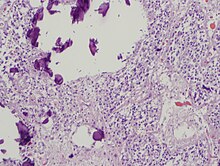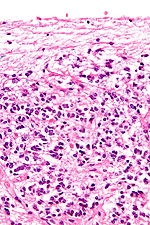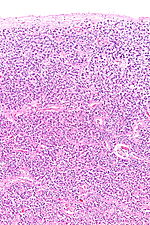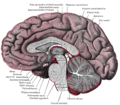he pineal gland, also known as the pineal body, conarium or epiphysis cerebri, is a small endocrine gland in the vertebrate brain. It produces melatonin, a serotonin derived hormone, which affects the modulation of sleep patterns in both seasonal and circadian rhythms.[1][2] Its shape resembles a tiny pine cone (hence its name), and it is located in the epithalamus, near the center of the brain, between the two hemispheres, tucked in a groove where the two halves of the thalamus join.
Nearly all vertebrate species possess a pineal gland. The most important exception is the hagfish, which is often thought of as the most primitive extant vertebrate.[3] Even in the hagfish, however, there may be a "pineal equivalent" structure in the dorsal diencephalon.[4] The lancelet Branchiostoma lanceolatum, the nearest existing relative to vertebrates, also lacks a recognizable pineal gland.[3] The lamprey (considered almost as primitive as the hagfish), however, does possess one.[3] A few more developed vertebrates, including the alligator, lack pineal glands because they have been lost over the course of evolution.[5]
The gland has been compared to the photoreceptive, third parietal eye present in the epithalamus of some animal species, which is also called the pineal eye. René Descartes believed the pineal gland to be the "principal seat of the soul" and viewed it as the third eye.[6]
Contents
[hide]Structure[edit]
The pineal gland is the only midline brain structure that is unpaired (azygous). It takes its name from its pine-cone shape.[7] The gland is reddish-gray and about the size of a grain of rice (5–8 mm) in humans. The pineal gland, also called the pineal body, is part of the epithalamus, and lies between the laterally positionedthalamic bodies. It is located in the quadrigeminal cistern near to the corpora quadrigemina.[8] It is also located behind the third ventricle and is bathed incerebrospinal fluid supplied through a small pineal recess of the third ventricle which projects into the stalk of the gland.[9]
Blood supply[edit]
Unlike most of the mammalian brain, the pineal gland is not isolated from the body by the blood–brain barrier system;[10] it has profuse blood flow, second only to the kidney.[clarification needed]
Innervation[edit]
The pineal gland receives a sympathetic innervation from the superior cervical ganglion. A parasympathetic innervation from the pterygopalatine and otic ganglia is also present. Further, some nerve fibers penetrate into the pineal gland via the pineal stalk (central innervation). Also, neurons in the trigeminal ganglion innervate the gland with nerve fibers containing the neuropeptide PACAP.
Histology[edit]
The pineal body consists in humans of a lobular parenchyma of pinealocytes surrounded by connective tissue spaces. The gland's surface is covered by a pial capsule.
The pineal gland consists mainly of pinealocytes, but four other cell types have been identified. As it is quite cellular (in relation to the cortex and white matter), it may be mistaken for a neoplasm.[11]
| Cell type | Description |
|---|---|
| Pinealocytes | The pinealocytes consist of a cell body with 4–6 processes emerging. They produce and secrete melatonin. The pinealocytes can be stained by special silver impregnation methods. Their cytoplasm is lightly basophilic. With special stains, pinealocytes exhibit lengthy, branched cytoplasmic processes that extend to the connective septa and its blood vessels. |
| Interstitial cells | Interstitial cells are located between the pinealocytes. They have elongated nuclei and a cytoplasm that is stained darker than that of the pinealocytes. |
| Perivascularphagocyte | Many capillaries are present in the gland, and perivascular phagocytes are located close to these blood vessels. The perivascular phagocytes are antigen presenting cells. |
| pinealneurons | In higher vertebrates neurons are usually located in the pineal gland. However, this is not the case in rodents. |
| peptidergicneuron-like cells | In some species, neuronal-like peptidergic cells are present. These cells might have a paracrine regulatory function. |
In some parts of the brain and in particular the pineal gland, there are calcium structures, the number of which increases with age, calledcorpora arenacea (or "acervuli," or "brain sand"). Chemical analysis shows that they are composed of calcium phosphate, calcium carbonate, magnesium phosphate, and ammonium phosphate.[12] In 2002, deposits of the calcite form of calcium carbonate were described.[13] Calcium and phosphorus[14] deposits in the pineal gland have been linked with aging.
Development[edit]
The human pineal gland grows in size until about 1–2 years of age, remaining stable thereafter,[15][16] although its weight increases gradually from puberty onwards.[17][18] The abundant melatonin levels in children are believed to inhibit sexual development, and pineal tumors have been linked with precocious puberty. When puberty arrives, melatonin production is reduced.[citation needed]
Function[edit]
Melatonin is N-acetyl-5-methoxy-tryptamine, a derivative of the amino acid tryptophan, which also has other functions in the central nervous system. The production of melatonin by the pineal gland is stimulated by darkness and inhibited by light.[19][20] Photosensitive cells in the retina detect light and directly signal the suprachiasmatic nucleus (SCN), entraining its rhythm to the 24-hour cycle in nature. Fibers project from the SCN to the paraventricular nuclei (PVN), which relay the circadian signals to the spinal cord and out via the sympathetic system to superior cervical ganglia(SCG), and from there into the pineal gland.
Regulation of the pituitary gland[edit]
Studies on rodents suggest that the pineal gland influences the pituitary gland's secretion of the sex hormones follicle-stimulating hormone (FSH), andluteinizing hormone (LH). In a study by Motta, Fraschini, and Martini (1967), a pinealectomy was performed on rodents. No change in pituitary weight was observed, however there was an increase in the concentration of FSH and LH within the gland. In this same study, administration of melatonin did not return the concentrations of FSH to normal levels, suggesting that the pineal gland influences the pituitary glands secretion of FSH and LH through some other transmitting molecule.[22]
Drug metabolism[edit]
Studies on rodents suggest that the pineal gland may influence the actions of recreational drugs, such as cocaine,[23] and antidepressants, such as fluoxetine (Prozac),[24] and that its hormone melatonin can protect against neurodegeneration.[25]
Clinical significance[edit]
Calcification[edit]
Calcification of the pineal gland is typical in adults, and has been observed in children as young as 2. Calcification rates vary widely by country and correlate with an increase in age, with calcification occurring in an estimated 40% of Americans by their 17th year.[26] Calcification of the pineal gland is largely associated with corpora arenacea also known as "brain sand".
It seems that the internal secretions of the pineal gland inhibit the development of the reproductive glands, because, in cases where it is severely damaged in children, the result is accelerated development of the sexual organs and the skeleton.[27] In animals, the pineal gland appears to play a major role in sexual development, hibernation, metabolism, and seasonal breeding.[28]
Some recent studies show that the degree of pineal gland calcification is significantly higher in patients with Alzheimer's disease vs. other types of dementia.[29]
Pineal gland calcification may also contribute to the pathogenesis of Alzheimer's disease and may reflect an absence of crystallization inhibitors.[29]
Calcium, phosphorus,[14] and fluoride deposits in the pineal gland have been correlated with aging, showing that, as the brain ages, more deposits collect.[30]
Cancer[edit]
Tumors of the pineal gland are called pinealomas. These tumors are rare and 50% to 70% are germinomas that arise from sequestered embryonic germ cells.Histologically they are similar to testicular seminomas and ovarian dysgerminomas.
A pineal tumor can compress the superior colliculi and pretectal area of the dorsal midbrain, producing Parinaud's syndrome. Pineal tumors also can cause compression of the cerebral aqueduct, resulting in a noncommunicating hydrocephalus.
These neoplasms are divided into two categories, pineoblastomas and pineocytomas,[citation needed] based on their level of differentiation, which, in turn, correlates with their neoplastic aggressiveness. The clinical course of patients with pineocytomas is prolonged, averaging 7 years.[citation needed] The manifestations are the consequence of their pressure effects and consist of visual disturbances, headache, mental deterioration, and sometimes dementia-like behaviour.[citation needed]The position of these tumors makes them very difficult or impossible to remove surgically.
Other animals[edit]
Pinealocytes in many non-mammalian vertebrates have a strong resemblance to the photoreceptor cells of the eye. Some evolutionary biologists believe that the vertebrate pineal cells possess a common evolutionary ancestor with retinal cells.[31]
Pineal cytostructure seems to have evolutionary similarities to the retinal cells of chordates.[31] Modern birds and reptiles have been found to express thephototransducing pigment melanopsin in the pineal gland. Avian pineal glands are believed to act like the SCN in mammals.[32]
In some vertebrates, exposure to light can set off a chain reaction of enzymatic events within the pineal gland that regulate circadian rhythms.[33] Some early vertebrate fossil skulls have a pineal foramen (opening). This correlates with the physiology of the modern "living fossils," the lampreys and the tuatara, and some other vertebrates that have a parietal eye, which, in some of them, is photosensitive. The parietal eye represents evolution's earlier approach to photoreception.[34] The structures of the pineal eye in the tuatara are analogous to the cornea, lens, and retina, though the latter resembles that of an octopus rather than a vertebrate retina. The asymmetrical whole consists of the "eye" to the left and the pineal sac to the right. "In animals that have lost the parietal eye, including mammals, the pineal sac is retained and condensed into the form of the pineal gland."[34]
Fossils seldom preserve soft anatomy. The brain of the Russian Melovatka bird, about 90 million years old, is an exception, and it shows a larger-than-expected parietal eye and pineal gland.[35]
In humans and other mammals, the light signals necessary to set circadian rhythms are sent from the eye through the retinohypothalamic system to thesuprachiasmatic nuclei (SCN) and the pineal gland.
Society and culture[edit]
Seventeenth century philosopher and scientist René Descartes, dedicating much time to the study of the pineal gland, called it the "principal seat of the soul".[36]He believed it to be the point of connection between the intellect and the body.[37] Descartes attached significance to the gland because he believed it to be the only section of the brain to exist as a single part rather than one-half of a pair. He argued that, because a person can never have "more than one thought at a time," external stimuli must be united within the brain before being considered by the soul, and he considered the pineal gland to be situated in "the most suitable possible place for this purpose," located centrally in the brain and surrounded by branches of the carotid arteries.[36]
Baruch de Spinoza criticized Descartes' viewpoint for neither following from self-evident premises nor being "clearly and distinctly perceived" (Descartes having previously asserted that he could not draw conclusions of this sort), and questioned what Descartes meant by talking of "the union of the mind and the body."[38]
The notion of a "pineal-eye" is central to the philosophy of the French writer Georges Bataille, which is analyzed at length by literary scholar Denis Hollier in his study Against Architecture. In this work Hollier discusses how Bataille uses the concept of a "pineal-eye" as a reference to a blind-spot in Western rationality, and an organ of excess and delirium.[39] This conceptual device is explicit in his surrealist texts, The Jesuve and The Pineal Eye.[40]
Numerous spiritual philosophies contain the notion of an inner third eye that is related to the Ajna chakra and also to the pineal gland. These are attributed significance in mystical awakening or enlightenment, clairvoyant perception, and higher states of consciousness. This idea occurs historically in ancient central and eastern Asia, as well as in contemporary theories relating to yoga, theosophy, Hinduism and pagan religions, and New Age spiritual philosophies.
History[edit]
The secretory activity of the pineal gland is only partially understood. Its location deep in the brain suggested to philosophers throughout history that it possesses particular importance. This combination led to its being regarded as a "mystery" gland with mystical, metaphysical, and occult theories surrounding its perceived functions.
The pineal gland was originally believed to be a "vestigial remnant" of a larger organ. In 1917, it was known that extract of cow pineals lightened frog skin. Dermatology professor Aaron B. Lerner and colleagues at Yale University, hoping that a substance from the pineal might be useful in treating skin diseases, isolated and named the hormone melatonin in 1958.[41] The substance did not prove to be helpful as intended, but its discovery helped solve several mysteries such as why removing the rat's pineal accelerated ovary growth, why keeping rats in constant light decreased the weight of their pineals, and why pinealectomy and constant light affect ovary growth to an equal extent; this knowledge gave a boost to the then new field of chronobiology.[42]
See also[edit]
Additional images[edit]
The pineal body is labeled in these images.





































No comments:
Post a Comment